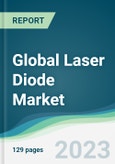The global laser diode market is expected to grow at a CAGR of 10.58% over the forecast period, from US$7.026 billion in 2021 to US$13.335 billion in 2028.
Laser diodes are semiconductor devices that produce coherent and directional light through stimulated emission. They are compact and efficient light sources utilized in telecommunications, healthcare, automotive, and industrial manufacturing. Different wavelengths and power levels enable customization for specific applications. The global laser diode market has witnessed a surge in demand due to its various applications in consumer electronics, healthcare, automotive, and industrial manufacturing. The market growth is attributed to high-speed data transmission needs, increased use of medical devices, and rising adoption in automotive manufacturing. Compact and energy-efficient lighting solutions, such as laser-based displays, have also boosted market growth. Further research and development are being conducted, leading to an expected market expansion in the future.Furthermore, Trumpf Group's 2022 report indicates a significant increase in sales revenue, from 3504.7 million Euro in 2021 to 4222.8 million Euro in 2022, with laser diodes playing a pivotal role in this growth. TRUMPF Photonic Components uses laser diodes in cellphones, digital data transfer, and sensors for self-driving vehicles.
The global laser diode market is driven by growing research and innovation.
Laser diodes have become increasingly important in many industries and are expected to grow with technological advancements. More than a billion cell phones globally already use this technology. In the production of batteries for electromobility, laser diodes are used to dry films. Several companies have launched innovative products and collaborated with other companies that have broadened the market size. For example, the Lawrence Livermore National Laboratory, which the US Department of Energy funds, is a leading research institution in developing high-energy lasers for applications such as fusion energy, national security, and industrial processing. In addition, academic institutions such as the University of California, Berkeley, and the Massachusetts Institute of Technology are researching new laser technologies and applications, such as laser-based cancer therapy and laser-based additive manufacturing.Market Developments:
- BluGlass announced in 2022 that it is optimizing the four fundamental components for dependable laser diodes - epitaxy, metals, facets, and bonds - to overcome reliability difficulties and launch its first commercial devices in the 405nm, 420nm, and 450nm wavelength ranges. Efficient thermal and mechanical bonds are crucial to the reliability of laser diodes, allowing for effective heat dissipation away from the device and enabling long-term high performance.
The United States accounts for a dominant share of the North American laser diode market.
The global laser diode market has been segmented by geography into North America, South America, Europe, the Middle East and Africa, and the Asia Pacific.The United States laser market is projected to witness positive growth during the projected period. This growth can be attributed to increased adoption in defense and aerospace applications, growing demand in medical devices and consumer electronics, the need for high-speed data communication infrastructure, advancements in laser technology, and the development of new applications. Further, the USA is a global leader in laser research and development, with several government and academic institutions driving innovation in laser technology.
The US Department of Defense has been investing heavily in developing laser-based weapons and systems in recent years. According to a 2020 report by the US Department of Defense, the department has been increasing its investment in directed energy weapons, which include laser systems, in recent years. The report stated that the department's fiscal year 2021 budget request had $1.6 billion for the development and fielding of directed energy weapons, an increase of $237 million over the fiscal year 2020 request. This highlights the continued investment by the US Department of Defense in laser-based weapons and systems, which is driving the increased adoption of laser diodes in defense and aerospace applications.
In conclusion, the increased adoption of laser diodes in various industries, such as defense, aerospace, medical devices, and consumer electronics, is driving the growth of the US laser market. The US Department of Defense's continued investment in directed energy weapons, which include laser systems, is a significant factor contributing to this growth. Additionally, advancements in laser technology and the development of new applications in various industries are further boosting the market. With the presence of leading research institutions and academic institutions focused on laser technology, the US is well-positioned to remain at the forefront of laser innovation and continue to drive the growth of the global laser diode market.
Market Segmentation:
BY DOPING MATERIAL
- InGaN
- AlGalnP
- GaAs
- GaAIAs
- GaInAsSb
BY END-USERS
- Automotive
- Aerospace and Defense
- Healthcare
- Consumer Goods
- Industrial
BY APPLICATION
- VCSEL Diode
- VECSEL Diode
- Quantum Well Laser Diode
- Quantum Cascade Laser Diode
BY WAVELENGTH
- Infrared Laser Diode
- Ultraviolet Laser Diode
- Red Laser Diode
- Blue Laser Diode
- Green Laser Diode
BY GEOGRAPHY
- North America
- USA
- Canada
- Mexico
- South America
- Brazil
- Argentina
- Others
- Europe
- UK
- France
- Germany
- Others
- Middle East and Africa
- Saudi Arabia
- UAE
- Others
- Asia Pacific
- China
- Japan
- India
- South Korea
- Taiwan
- Thailand
- Indonesia
- Others
Table of Contents
1. INTRODUCTION
2. RESEARCH METHODOLOGY
3. EXECUTIVE SUMMARY
4. MARKET DYNAMICS
5. LASER DIODE MARKET BY DOPING MATERIAL
6. LASER DIODE MARKET BY END-USERS
7. LASER DIODE MARKET BY APPLICATION
8. LASER DIODE MARKET BY WAVELENGTH
9. LASER DIODE MARKET BY GEOGRAPHY
10. COMPETITIVE ENVIRONMENT AND ANALYSIS
11. COMPANY PROFILES
Companies Mentioned
- Coherent Inc
- Cutting Edge Optronics Inc. (Northrop Grumman Corp.)
- IPG Photonics Corporation
- OSRAM Opto Semiconductors Inc.
- TRUMPF Inc.
- Sharp Corporation
- Sumitomo Corporation
- ROHM Semiconductor USA LLC
- Frankfurt Laser Company
- OSI Laser Diode Inc.
Methodology

LOADING...








